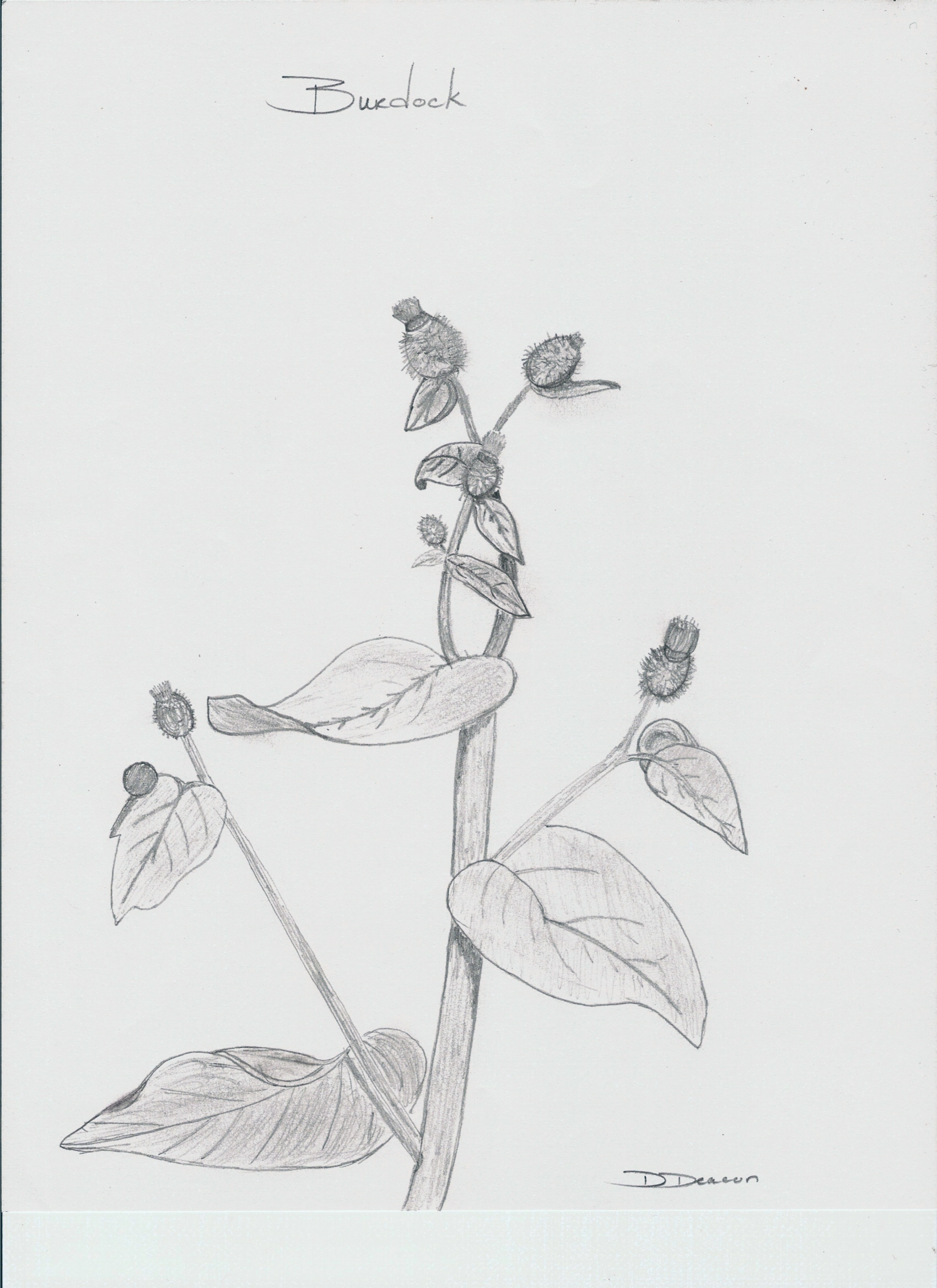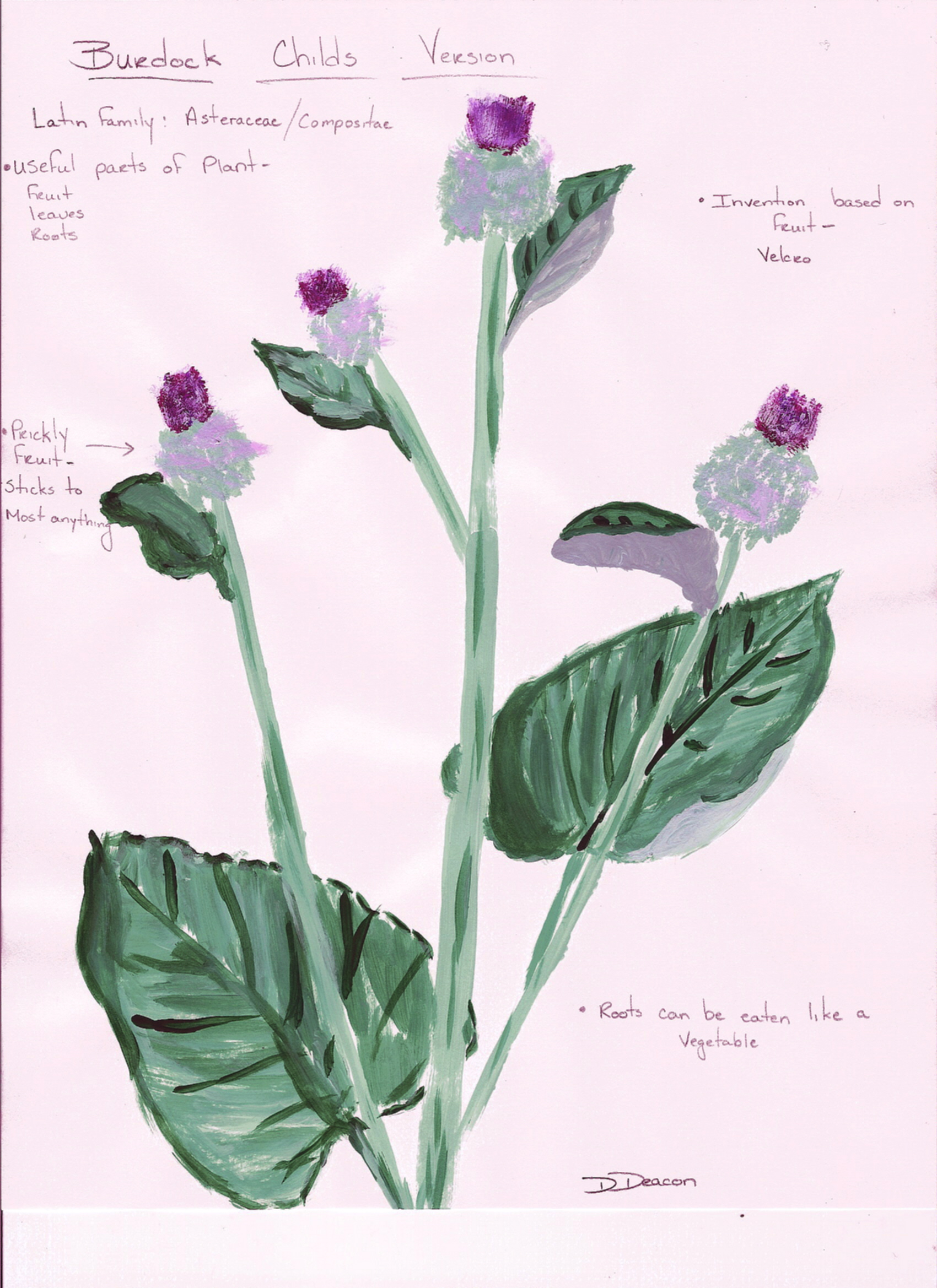The Evergreen State College
Olympia, WA
BURDOCK
Latin Family: Asteraceae/Asteraceae
English Family: Aster/Compositae
Latin Name: Arctium lappa-Greater Burdock
Arctium minus-Lesser Burdock
Arctium vulgare-Woodland Burdock
Arctium pubens-common Burdock
Arctium tomentosum-Downy Burdock
Common Names: Thorny Burr, Beggar’s Button, Love Leaves, Happy Major, Etc.
Related species: Burdock is closely related to the genus Cousinia and is commonly
confused with the genus’s Xanthium and Rheum.
Body System Affiliations: Digestive System, Urinary System, Reproductive System, First
Aid and Skin.
Botanical Description:
Habitat: It is a biennial shrub that is most commonly found in old fields, places of
waste, where the soil is disturbed and along roadsides usually in damp
areas.
Size: Greater Burdock can grow up to a height of nine feet where as most of
the other species of burdock usually have a range from three to five feet
in height.
Leaves: The leaves vary in size, shape and color. The leaves at the bottom of the
plant are large, approximately 18in. by 8in., and they are heart shaped.
Towards the top of the plant the leaves become much smaller and more
oblonged shaped like an egg. Depending upon the variety of Burdock
the color may also vary from a dark green to a lighter color of green on
the top of the leaves and a grayish color on the under side.
Flowers: This plant has bright purple flowers that are about one to two inches in
size and grows in overlapping bracts with hooked tips. It generally
flowers in July and August.
Fruit: The fruit forms from the prickly flower and is commonly but mistakenly
called the seed.
Bark: The roots have a thin layer of bark that should be peeled after harvesting.
Underground Parts: Burdock grows from a biennial root.
Ecology:
Habitat: Burdock is most commonly found in regions that have adequate moisture
with soil that has good drainage, such as disturbed sites, like construction
sites, roadsides, hillsides, etc..
Ecology:
Range: The various species of Burdock grow over a widespread area. They grow
throughout most of North America, Europe, and Asia.
Western Uses:
Food: Burdock root can be and is eaten as a vegetable both raw and cooked. In
the United Kingdom it has been a very popular soft drink when mixed
with dandelions. It is most commonly known tea use.
Materials/Technology:
In the 1940s an inventor named George De Mestral, while studying the
Burdock fruit, came up with the idea to create the material now know as
Velcro. Also in 1896 Leo Tolstoy, a Russian writer, wrote in his journal
that a lone plant in a desolate field, Burdock, gave him great inspiration
to write.
Medicine:
Part Used: Roots, Leaves, and fruits (Americans typically only use the fruits.)
Medicinal Actions: Diuretic and Diaphoretic
Indications: Heart failure, liver cirrhosis, hypertension, kidney diseases, dandruff
or itchy scalp, gout, ulcers, arthritis, rheumatism, and other skin conditions
Body System Associations: Digestive System, and Skin
Applications: Burdock can be used as an infusion, decoction, tincture, fluid
extract and poultice.
Preparations: For roots, dig up and harvest first or second year plants from July to
November. Peel the bark off and clean the roots well also check for rot.
Then cut the roots into thin pieces and let dry. Once dry they are ready to
be used as is or to be crushed into powder and turned into caplet
form (pills). The roots and the fruits can be used as a decoction of one
ounce to one and a half pints of water boiled down to one pint. The leaves
are also collected in July for drying. They as well as the fruits can be used
as an infusion, which means they are added to already boiling water.
Lightly cover the surface area of the pot or a cup and let stand for several
minutes and it is ready. The leaves are also used as a poultice when
applied externally. Bruise the leaves and apply to the afflicted area. A
medicinal tincture and a fluid extract can also both be prepared from the
fruit. A fluid extract can also be taken from the root.
Pharmacy: Burdock crushed into caplet form is taken, one caplet three times a
day. Decoctions and infusions drinks are taken one cup two to three times
a day. Poultice (topical) treatments are done once to twice a day. For root
fluidextract one half to two drachms are taken, for fruit fluidextract 10to 30 drops are taken.
Cautions: None found
Indigenous and Non-Western Use:
Food: Burdock root is a popular vegetable in Asian and Japanese cuisine and can be eaten
raw or cooked. It is called “Gobo” in Japan.
Medicine:
Group: Asians
Part Used: Roots, Leaves, and fruits (Americans typically only use the fruits.)
Medicinal Actions: Diuretic, Diaphoretic, and Reproductive System
Indications: Heart failure, liver cirrhosis, hypertension, kidney diseases, dandruff
or itchy scalp, gout, ulcers, arthritis, rheumatism, and other skin conditions, impotence, and sexual dysfunction.
Energetics: The Burdock leaves in Chinese culture are thought to have cooling
and moderately drying properties.
Harvest: The roots can be gathered from July through November. The leaves are
collected for drying in July. The fruits are collected when ripe, shaken out
of the head and dried in the sun.
Applications: Burdock can be used as an infusion, decoction, tincture, fluid
extract and poultice.
Preparations: For roots, dig up and harvest first or second year plants from July to
November. Peel the bark off and clean the roots well also check for rot.
Then cut the roots into thin pieces and let dry. Once dry they are ready to
be used as is or to be crushed into powder and turned into caplet
form (pills). The roots and the fruits can be used as a decoction of one
ounce to one and a half pints of water boiled down to one pint. The leaves
are also collected in July for drying. They as well as the fruit can be used
as an infusion, which means they are added to already boiling water.
Lightly cover the surface area of the pot or a cup and let stand for several
minutes and it is ready. The leaves are also used as a poultice when
applied externally. Bruise the leaves and apply to the afflicted area. A
medicinal tincture and a fluid extract can also both be prepared from the
fruit. A fluidextract can also be taken from the root.
Pharmacy: Burdock crushed into caplet form is taken, one caplet three times a
day. Decoctions and infusions drinks are taken one cup two to three times
a day. Poultice (topical) treatments are done once to twice a day. For root
fluid extract one half to two drachms are taken, for fruit fluidextract 10
to 30 drops are taken.
Cautions: None found
Harvest:
Plant Part: Root
Season of Harvest: Summer and Autumn
Method of Harvest: Dig up with shovel or beet digger
Ecological Considerations: Erosion, vegitation death
Cautions: Wear long sleeves, barbs from fruits attach
Harvest:
Plant Part: Leaves
Season of Harvest: Summer
Method of Harvest: Clip when green and let dry
Ecological Considerations: Vegitation death
Cautions: Barbs on fruit
Harvest:
Plant Part: Fruit
Season of Harvest: Summer and Autumn (when ripe)
Method of Harvest: Pick fruit, shake out head of flower and let dry
Ecological Considerations: Reduced plant growth
Cautions: Barbs on fruit
Personal Experience: None Yet
Sources:
1. Author Unknown. Wikipedia. Online at http://en.wikipedia.org/wiki/Burdock. last update 6 Feb 2006. Visited 13 Feb 2006
2. Grieve,M. A Modern Herbal. 95-06. Online at http://botanical.com/botanical/mgmh/b/burdoc87.html
3. Martin, Corinne. Herbal Remedies From The Wild.Woodstock, Vermont: The Countryman Press, 2000
4. Duke, James, A. The Green Pharmacy. Emmaus, Pennsylvania: Rodale Press, 1997.
Summary:
Burdock is a natural alternative to pharmaceutically produced medicines for the aid and benefit of the human digestive, urinary, and reproductive systems. The roots, leaves and fruit of the Burdock plant can be used for medicinal purposes in a variety of ways. It is useful for first aid treatments and, more specifically, for the heart, liver, kidneys, arthritic conditions and skin problems such as eczema. This plant is very easy to come by and grows throughout most of North America, Europe and Asia.
Burdock also has a long-standing history of being used as a food source. Throughout Europe and Asia it is used as a vegetable, tea and even in some parts of Europe, as a soft drink.
The Burdock plant has been the inspiration of inventions like Velcro and has also given the creative inspiration to people such as Leo Tolstay and William Shakespeare to write, or to write about this plant.

